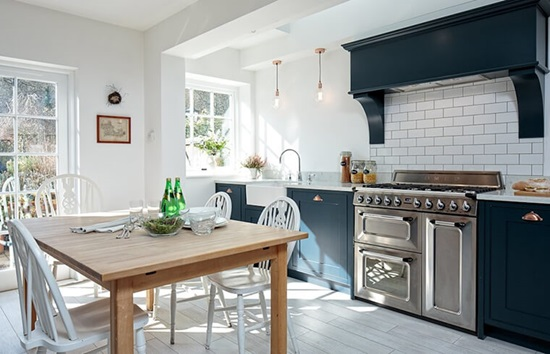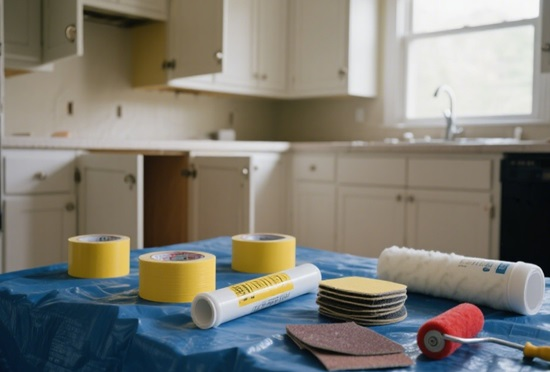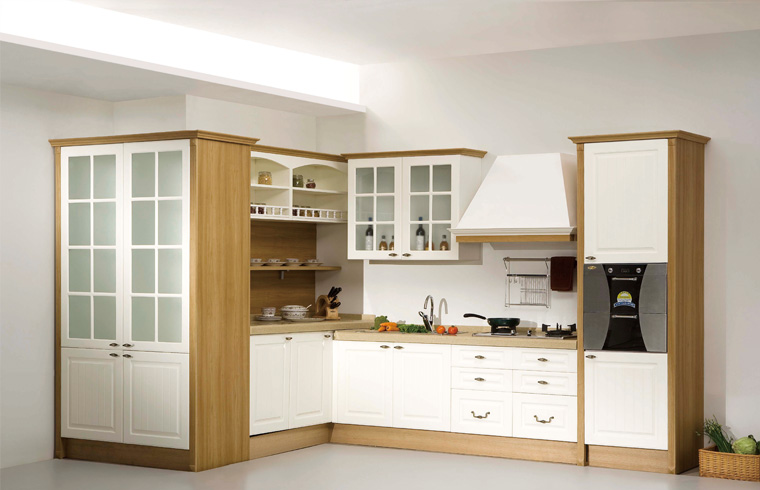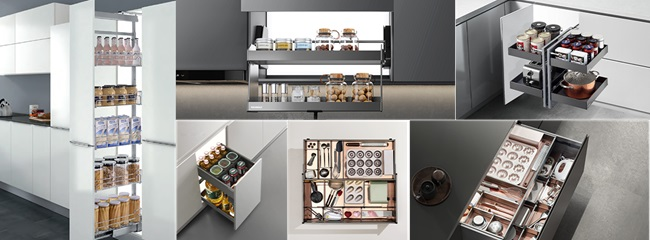Repainting your kitchen cabinets is one of the most affordable and high-impact ways to refresh your kitchen without undergoing a full renovation. Unlike cabinets in other parts of the home, kitchen cabinets endure daily exposure to grease, steam, fingerprints, and fluctuating humidity. That means this project is about more than just picking a pretty color—it's about durability, proper prep, and knowing how paint performs under kitchen conditions.

Painting offers homeowners a way to update their kitchen at a fraction of the cost of new cabinets. For many, the bones of the kitchen are still solid—the layout works, the storage is sufficient—but the finish is outdated or worn. Painting gives those surfaces a clean, fresh look without tearing anything out.
It's also far less disruptive. A full cabinet replacement often involves plumbers, electricians, and weeks of construction. Painting can be done in days, with less mess and at a much lower cost.
A new coat of paint doesn't just improve appearance—it changes how the space feels. Bright white can open up a dark kitchen. A soft sage can add warmth. And deep navy can give older cabinets a sleek, modern edge.
Average Cost to Paint Kitchen Cabinets
So how much does it cost to paint kitchen cabinets? For most homes, the price ranges between $1,200 and $4,500, depending on who's doing the work and how big the kitchen is. That includes everything from prep and priming to labor and paint.
A small kitchen with about ten cabinet doors may cost closer to $1,000 if you do it yourself. But hiring a professional for a large, detailed job can push the cost past $5,000. The range is wide because kitchens—and expectations—vary widely.
Compared to the $10,000 or more often required for a full replacement, painting remains the most cost-effective way to update your kitchen's look without overhauling the entire space.
The number of doors and drawers is the most obvious driver of cost. More surfaces mean more prep, sanding, priming, and painting. That means more time, more paint, and often more labor.
Condition matters, too. If your cabinets are coated in years of grease or have deep scratches, the prep work will take longer. The painter may need to do extra cleaning, fill damaged areas, or apply stain-blocking primer before painting even begins.
Cabinet material also makes a difference. Solid wood usually paints well, but laminate or thermofoil surfaces may need special products—or might not hold paint well at all. These materials can increase cost or limit your finish options.
Most professional painting quotes include labor, paint, supplies, and cleanup. Labor is almost always the biggest part, often making up 60% to 80% of the total cost. The more complex the job, the more you'll pay for skilled, careful application.
Paint itself may cost less than $100 per gallon, but the type of paint matters. High-end cabinet paints are thicker, more durable, and formulated to resist fingerprints, water, and grease. You'll likely need two coats, plus primer, so material costs can add up quickly.
Supplies—like tape, caulk, sandpaper, drop cloths, and rollers—seem minor but are essential. These often aren't itemized on quotes, but they factor into your final bill all the same.

Painting cabinets looks simple—but the process is more involved than most expect. If you've got time, patience, and the right tools, DIY might save you money. A basic DIY job can cost as little as $200–$600, mostly for paint and supplies.
However, the time investment is significant. Prepping cabinets correctly takes hours, sometimes days. You'll need to remove hardware, label doors, degrease surfaces, sand everything, and apply multiple coats. Mistakes—like drips, streaks, or improper bonding—can ruin the final look.
Hiring a professional avoids those risks. Painters come equipped with sprayers, masking tools, and commercial-grade primers. They're faster, cleaner, and often more consistent. But that speed and expertise come at a cost. You'll pay more upfront but likely get a more durable and polished finish.
Some of the biggest cost increases come from having to fix things that went wrong the first time. The most common issue is poor surface prep. Cabinets may look clean, but cooking grease, hand oils, and dust prevent paint from sticking.
Skipping primer is another mistake. Some paints advertise “paint and primer in one,” but for cabinets, that rarely holds up. Without a proper base coat, paint chips more easily and wears down faster—especially in high-use areas.
Painting over damaged wood, skipping sanding, or applying thick coats can all lead to early failure. When that happens, you may end up repainting within months—essentially paying twice for the same result.
There are limits to what paint can fix. If your cabinets have structural damage—like sagging frames, warped doors, or broken joints—painting won't solve the problem. In fact, it may make the flaws more noticeable.
Cabinets made from low-grade materials, like particle board or vinyl veneer, may not hold paint well. Some will peel or bubble shortly after the project is done, regardless of prep. If that happens, you'll be left with a finish that wears quickly and looks worse than before.
Also consider layout. If your kitchen feels cramped or your storage isn't working, paint won't help. In these cases, it might make more sense to invest in new cabinetry or a redesign that better suits your needs.

A well-done cabinet paint job can last 5 to 10 years, depending on the paint used and how heavily the kitchen is used. Daily wear and tear adds up, especially in homes with children, pets, or lots of cooking activity.
The choice of paint matters a lot here. Oil-based or enamel hybrid paints tend to last longer than latex. Finishes also help—semi-gloss and satin are common for their durability and ease of cleaning.
How you treat the cabinets also plays a role. Soft-close hinges, gentle cleaners, and avoiding harsh scrubbing can all extend the life of your finish. When minor chips appear, they can usually be touched up without repainting the entire kitchen.
Painting is a popular option, but not the only one. Refacing replaces only the cabinet doors and drawer fronts while leaving the boxes in place. It costs more than painting—usually between $4,000 and $8,000—but gives a more dramatic transformation.
Vinyl wrap or peel-and-stick laminates are another option. These materials stick directly to cabinet surfaces and come in dozens of colors and textures. They're fast, affordable, and great for rental properties—but not as durable as paint.
Even something as small as changing cabinet hardware or adding open shelving can freshen up the space. If your cabinet bodies are still in great shape, small design changes might offer enough of a refresh without the cost of painting.

There are smart ways to save money on cabinet painting while still getting professional results. One is to do the prep work yourself. Cleaning, degreasing, and even removing cabinet doors can reduce the time a pro spends on-site—and that means lower labor costs.
Choose neutral paint colors that require fewer coats. Dark colors often need more layering to look consistent. Lighter tones like white, cream, or soft gray usually cover better, especially over already light finishes.
If you're hiring a professional, get multiple quotes and ask what's included. Some painters bundle hardware removal, others don't. Some spray doors off-site, others paint in place. Understanding exactly what's in the price helps you compare fairly.
You can also buy your own paint, if the painter allows. This gives you control over cost and brand. Just be sure to ask what type of paint works with their system so you don't create compatibility issues.
In most cases, painting kitchen cabinets is a cost-effective way to breathe new life into your kitchen. It's far less expensive than replacing cabinets and offers a big visual payoff. But the quality of the job matters—cutting corners can lead to short-lived results and extra expenses down the line.
If your cabinets are in good shape structurally, and your kitchen layout still works for your lifestyle, painting is a smart move. It's a blend of budget-conscious thinking and aesthetic upgrade that makes sense for many homeowners.
Whether you're doing it yourself or hiring a pro, knowing the true cost to paint kitchen cabinets—including time, materials, and potential pitfalls—helps you plan and spend wisely.
If you're planning to refresh your kitchen without the cost of full renovation, painting your cabinets can offer remarkable results with modest investment. Just make sure the project matches the condition of your current cabinetry.
BFP's kitchen cabinets offer a wide variety of inner dividers and kitchen accessories to help you maximize organization whether you're painting your current setup or considering a new one. For more details, contact us at sales7@bfpglobal.com.
We employ cookies to analyze website traffic and enhance your browsing experience. Data securely aggregated, privacy protected. See Privacy Policy for details.